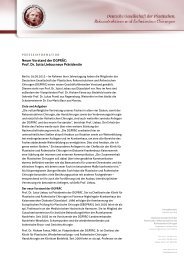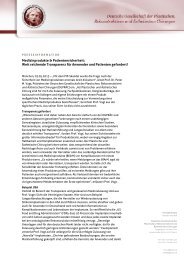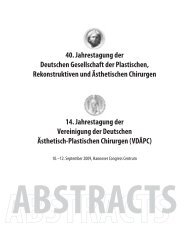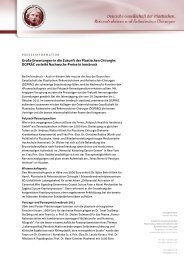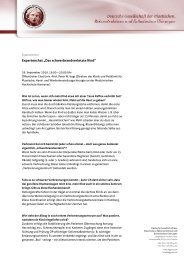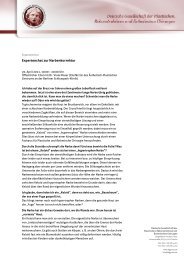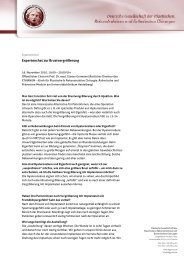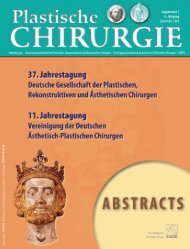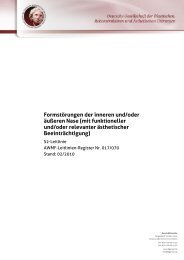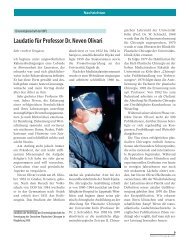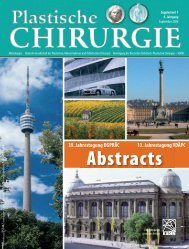ABSTRACTS
ABSTRACTS
ABSTRACTS
Erfolgreiche ePaper selbst erstellen
Machen Sie aus Ihren PDF Publikationen ein blätterbares Flipbook mit unserer einzigartigen Google optimierten e-Paper Software.
34. Jahrestagung der Deutschen Plastischen Chirurgen<br />
8. Jahrestagung der Deutschen Ästhetisch-Plastischen Chirurgen<br />
günstig Defekte verschließen. Als dreidiemensionaler Hautgewebeersatz<br />
ist am Larynx zusätzlich die Stabilisierung mittels in den Lappen transplantierten<br />
Rippenknorpels erforderlich, um den Kehlkopf bei der Inspiration<br />
und Phonation ausreichend Stabilität zu geben. Repräsentativ<br />
wird an 2 Beispielen von Patienten mit laryngocutanen Fisteln nach<br />
tumorchirurgischen Eingriffen die Möglichkeit der Präfabrikation und<br />
Prälaminierung dreidimensionaler Lappenplastiken zur Funktionswiederherstellung<br />
des oberen Aerodigestivtraktes aufgezeigt.<br />
P132 Effizienz und Sicherheit der Liposuktion<br />
und Hautmantelreduktion als Therapie der benignen symmetrischen<br />
Lipomatose<br />
T. Ferbert, U. Russ, I. Kuhfuß, U. Ziegler, H.P. Keller<br />
Chirurgische Universitätsklinik Würzburg, Handchirurgie und Plastische Chirurgie<br />
Die Benigne Symmetrische Lipomatose (BSL) ist eine seltene Erkrankung,<br />
welche durch vergrößerte, symmetrische, nicht verkapselte Fett-<br />
Gewebeansammlung vornehmlich an Hals und Schultergürtel charakterisiert<br />
ist. Die BSL ist häufig mit Alkoholabusus, Hepatopathien, Glukoseintoleranz<br />
und malignen Tumoren assoziiert. Das Ziel dieser Studie ist<br />
es, die Effizienz und Sicherheit der Liposuktion in Kombination mit<br />
Hautstraffung zu evaluieren.<br />
Methode: Von 1995 bis 2002 wurden 34 Patienten mit insgesamt 106 Operationen<br />
behandelt. Alle Patienten wurden entweder nur mit Liposuktion<br />
oder mit Liposuktion und Hautstraffung therapiert. Bei allen Patienten<br />
wurde mindestens zweimal oder häufiger eine Fettgewebsabsaugung<br />
durchgeführt.<br />
Ergebnisse: Durch die serielle Liposuktion kann eine schnelle Verbesserung<br />
der klinischen und ästhetischen Symptome erzielt werden. Zur Komplettierung<br />
der Therapie wurde die Hautmantelreduktion bei 11 der 32<br />
Patienten durchgeführt.<br />
Fazit: Die serielle Liposuktion bei BSL ist die Therapie der Wahl. Bei besonders<br />
starker Ausprägung sollte auch eine Hautmantelreduktion am Ende<br />
der Therapie durchgeführt werden.<br />
P133 Erich Lexer – Father of „The Entire Reconstructive<br />
Surgery“<br />
A. Gohritz, M.H.B. Kelly*, W. Mühlbauer<br />
Department of Plastic and Hand Surgery, Burn Center, Klinikum Bogenhausen, Teaching Hospital of the<br />
Technical University Munich, *Craniofacial Plastic Surgery Unit, Chelsea & Westminster Hospital, London<br />
Erich Lexer, born in Freiburg in 1867, was the foremost pioneer of plastic<br />
and reconstructive surgery in Germany until his death in 1937.<br />
However, despite the unique variety of his contributions his name seldomly<br />
appears in the international literature even when references are<br />
made to his original operations.<br />
This maybe due to the language barrier, as only very few of his publications<br />
were translated into English and many of his ideas were published<br />
in his books and not in article form. In addition, many of his procedures<br />
have been „re-invented „ later - omitting Lexer ‘s role - and some of his<br />
developments are attributed to other authors today, also as Lexer was<br />
reluctant to be co-author when permitting assistants to publish methods<br />
he had developed himself.<br />
The objective of this paper is to provide an overview of the substantial<br />
contributions given by Lexer which continue to influence our speciality.<br />
Regarding the unparalleled diversity of his work this survey concentrates<br />
on the areas that chosen as the main topics of this congress.<br />
Lexer was appointed as Professor of Surgery in Königsberg in 1905, later<br />
moved to Jena (1910 - 19) and organized a center for reconstructive sur-<br />
Plastische Chirurgie 3 (Suppl. 1): 93 (2003)<br />
gery in Flanders during WW I. He reached the zenith of his professional<br />
career in Freiburg (1919 - 28) where he completed his work „Die freien<br />
Transplantationen“ (Free Transplantations, 1919 / 24) which summarized<br />
his pioneering experimental and clinical research of transplantation<br />
of tissues such as fat, fascia, tendons, nerves and bone and joints (e. g.<br />
first osteoarticular transplants performed in 1908). Lexer was the director<br />
of the University Clinic in Munich from 1929 until 36 where he finished<br />
his opus magnum „Die Gesamte Wiederherstellungschirurgie (The<br />
Entire Reconstructive Surgery, 1931) uniting the knowledge of his time<br />
and his unchallenged experience. Many new ideas for complex head and<br />
neck reconstructions were created during the war including replacement<br />
of eyelashes and eyebrows with scalp grafts or total nose reconstructions<br />
using arm flaps preformed with a bony component. Lexer was the first to<br />
publish on techniques of muscle transfer and myoneurotization in patients<br />
of facial palsy in 1911. In the same year he described the first successful<br />
jejuno-dermato-esophago-plasty to replace the entire esophagus<br />
and a method to bridge urethral defects utilizing the appendix.<br />
In hand surgery, he was the first to advocate radical palmar aponeurectomy<br />
in Dupuytren ‘ s contracture and to use skin grafts to replace the<br />
excised parts of the palm. Lexer used this technique, published by his assistant<br />
Janssen in 1902, in nearly 200 cases until mentioning it in one of<br />
his books almost 30 years later. He introduced free tendon grafts in 1908<br />
for flexor tendon injuries and used the first autologous vein graft to bridge<br />
an arterial defect (in a case of subclavian aneurysm) in 1907. Lexer restored<br />
finger joints with articular toe transplants in 6 cases until 1913 and<br />
developed an own technique to overcome finger clawing in ulnar palsy.<br />
His breast reduction with an \“open\“ nipple-areola-complex transposition<br />
which preserved the continuity of the skin to the remaining gland<br />
and thus maintained breast function (published in 1921) was far ahead<br />
of its time as modifications of this concept did not become popular until<br />
1955. Lexer first proposed subcutaneous mastectomy for fibrocystic<br />
disease, to perform breast augmentation in the ptotic hypoplastic breast<br />
with fat flaps and to use free fat grafts from the abdomen or hips for breast<br />
augmentation, facial plasty and scar revision. He was among the first to<br />
perform a face-lift procedure (in 1906).<br />
In summary, Lexer’s work - written in a beautiful classic German style,<br />
without any unnecessary phrase - continues to offer scientific as well as<br />
literary inspiration. His energetic devotion to the progress in plastic and<br />
reconstructive as well as aesthetic surgery is still a role model proving his<br />
own remark: „Chirurgie ist Handwerk, Wissenschaft und Kunst“ (Surgery<br />
is craft, science and art).<br />
P134 Möglichkeiten und Ergebnisse der plastischchirurgischen<br />
Therapie von exponierten Totalendoprothesen im<br />
Kniebereich<br />
R. Hierner 1 , P. Reynders 2<br />
UZ. Gasthuisberg, Katholische Universität Leuven ( 1 Plastische Chirurgie, 2 Traumatologie)<br />
Abstracts<br />
Das bisherige Konzept bei exponierter Totalendoprothese sieht eine Prothesenexplantation,<br />
und Weichteilsanierung im 1. Schritt und eine Reimplantation<br />
im Intervall im 2. Schritt vor. Aufgrund der positiven Erfahrungen<br />
beim Einsatz von Muskellappenplastiken bei der Behandlung von<br />
Osteitiden, belassen wir bei fehlenden Lockerungszeichen im Prothesenlager,<br />
die Prothese in situ, führen ein adäquates Debridement durch<br />
und decken den Defekt mit einer Muskellappen - oder myo-kutanen Lappenplastik.<br />
Material und Methode: Im Zeitraum von 1994 bis 5/2001 haben wir 14 Patienten<br />
mit exponierter Totalendoprothese im Kniebereich behandelt. Es<br />
handelt sich um 5 Männer und 9 Frauen im Alter von 42 - 74 (Durchschnitt<br />
59) Jahren. Bei 5 Patienten erfolgte die Prothesenimplantation<br />
93





